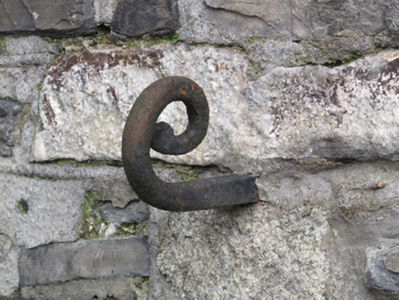Survey Data
Reg No
50070171
Rating
Regional
Categories of Special Interest
Architectural, Historical, Social
Previous Name
Royal Barracks
Original Use
Stables
Date
1820 - 1840
Coordinates
313993, 234578
Date Recorded
14/11/2012
Date Updated
--/--/--
Description
Detached ten-bay two-storey stable block, built c.1830, having gymnasium to first floor. Now disused. Central red brick extension to first floor to front (south) elevation, supported on red brick piers, built c.1900, lean-to extension to west elevation. Pitched slate roof with red brick chimneystacks, timber eaves courses and cast-iron rainwater goods. Snecked dressed calp limestone walls with block-and-start quoins, granite string course at first floor sill level, red and yellow brick string course at first floor impost level, cast-iron ventilation openings and cast-iron hooks to ground floor to front. Round-arched panel to gables, yellow brick voussoirs, granite sill, blocked. Red brick, laid in English garden wall bond, to extension to front. Yellow brick, laid in English garden wall bond, to first floor of lean-to extension to west, coursed calp limestone to lower level. Red brick walls to garden wall height, laid in English garden wall bond, projecting from front of building. Round-arched window openings to first floor having yellow brick voussoirs, red brick block-and-start surrounds, granite sills and timber sash windows: three-over-six pane with integral fanlight. One window opening in use as fire escape, with glazed timber door and steel escape staircase. Square-headed windows to ground floor having red brick surrounds, cut granite sills, and timber framed windows, some openings blocked. Square-headed door openings with red brick voussoirs and surrounds, overlights, some having timber battened half-doors, some with replacement steel doors. Round-arched door opening at first floor level to rear (north) elevation having yellow brick voussoirs, red brick surround, and double-leaf timber panelled door, fanlight over and canopy supported on cast-iron columns, door opens onto perron with granite steps, flanked by wrought-iron railings. Round-arched openings to perron, red brick voussoirs. Square-headed opening to rear of lean-to to west, timber door opening onto render platform.
Appraisal
The construction of the Royal Barracks was initiated by the 2nd Duke of Ormonde at the close of the seventeenth century, and was funded by a tax on tobacco and beer. Such a large scale residential barracks was an entirely new concept, and until the departure of the Irish Army from the site in the twenty-first century, it was considered the largest and oldest occupied barracks in Europe. This fine and imposing structure of balanced proportions was constructed, along with its neighbour to the east, as a stable range. Its construction is indicative of the ongoing development and expansion of the Royal Barracks. The regularity of design and proportion can be seen in the even fenestration arrangement, the high placement of ground floor windows emblematic of the use of the building as a stable, and is complemented by effective use of polychrome brick and granite detailing, adding visual and textural interest to the façade.





































